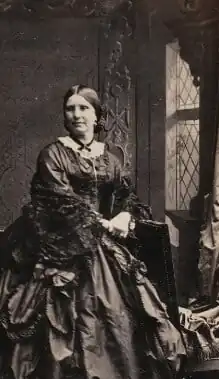Sir Frederick Adair Roe, 1st Baronet
Sir Frederick Adair Roe, 1st Baronet (19 March 1789 – 20 April 1866) was a British barrister and magistrate who was the Chief Metropolitan Police Magistrate from 1832 to 1839.
| Roe baronets | |
|---|---|
.svg.png.webp) Escutcheon of the Roe baronets of Brundish | |
| Creation date | 1836[1] |
| Status | extinct |
| Extinction date | 1866 |
| Motto | Tramite recta, By a straight path[1] |
Early life and background
He was the youngest son of William Roe, sometime chairman of the Board of Customs, and his wife Susannah Margaret Thomas, daughter of Sir George Thomas, 2nd Baronet of Yapton.[1][2] His mother's sister Lydia Thomas married in 1783 the army contractor Alexander Adair, who died in 1834 at age 95 leaving a large fortune, some of which came to Roe and real property in which was left in trust, to Roe's putative children.[3][4]
Career
Roe was educated at Westminster School.[5] He matriculated at Christ Church, Oxford in 1806, where he graduated BA in 1810 and MA in 1812.[2][6] Roe was called to the Bar at Lincoln's Inn in 1816. He was appointed a police magistrate at Marlborough Street in 1822, and chief magistrate at Bow Street in 1832, retiring on a pension in 1839.[2][6] He was knighted in 1832 and created a Baronet, of Brundish, in the county of Suffolk, in 1836.
Retirement
With a reported £100,000 from the personal property of the Adair estate, Roe retired from his work as chief magistrate. William Ballantine, who knew him as a family friend, wrote:
He was a tall, handsome, gentlemanly man, who had the reputation of having enjoyed life in many phases. He succeeded to a large fortune, and retired from the bench.[7]
His father, William Ballantine the elder (1778/9–1852), was a magistrate of the River Thames police, and commanded the river police force. He congratulated Roe on his "accession to wealth". Roe replied with a sign "Ah! [...] it has come too late."[7][8]
Death and legacy
The baronetcy became extinct on Roe's death. His wife Lady Roe survived to 1884. He left property including Dale Park, Beach House, Worthing and a London house at 27 Piccadilly. The major legatee was Sir William Thomas, 5th Baronet, who commanded the royal yacht HMY Victoria and Albert.[9] Paintings and other works of art from Roe's collection were put up for auction in 1867.[10]
Family

Roe married in 1831 Mary Ann Knowles, daughter of George Knowles of Emsal (South Elmsall), Yorkshire. They had no children, and on Roe's death the baronetcy became extinct.[11][12]
References
- Genealogical and Heraldic Dictionary of the Peerage and Baronetage of the British Empire. Burke's Peerage Limited. 1850. p. 844.
- "Sir F. A. Roe, Bart". The Gentleman's Magazine and Historical Review. Vol. I. January–June 1866. p. 907.
- Oliver, Vere Langford (1894). The history of the island of Antigua, one of the Leeward Caribbees in the West Indies, from the first settlement in 1635 to the present time. London, Mitchell and Hughes.
- The Gentleman's Magazine. F. Jefferies. 1834. p. 318.
- Welch, Joseph (1852). The List of the Queen's Scholars of St. Peter's College, Westminster: Admitted on that Foundation Since 1633; and of Such as Have Been Thence Elected to Christ Church, Oxford, and Trinity College, Cambridge, from the Foundation by Queen Elizabeth, 1561, to the Present Time. To which is Prefixed, a List of Deans of Westminster, and of Christ Church, Oxford; the Masters of Trinity College, Cambridge; and the Masters of Westminster School. G.W. Ginger. p. 465.
- Foster, Joseph (1888–1892). . Alumni Oxonienses: the Members of the University of Oxford, 1715–1886. Oxford: Parker and Co – via Wikisource.
- Ballantine, William (1882). Some experiences of a barrister's life. London, R. Bentley & Son. p. 78.
- Matthew, H. C. G. "Ballantine, William (1812–1887)". Oxford Dictionary of National Biography (online ed.). Oxford University Press. doi:10.1093/ref:odnb/1227. (Subscription or UK public library membership required.)
- "Beach House". Worthing Herald. 27 October 1928. p. 10.
- Athenaeum and Literary Chronicle. British Periodicals Limited. 1867. p. 103.
- Debrett, John (1840). The baronetage of England. revised, corrected and continued by G.W. Collen. p. 469.
- Nichols, John Gough (1867). The Herald and Genealogist. Nichols. p. 187.